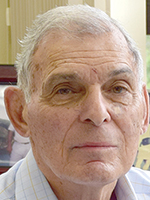Opinion: How Robin Hood Would Fund Our Infrastructure
Numerous studies by the Department of Transportation, the Association of State and Highway Transportation Officials, American Trucking Associations and the American Road and Transportation Builders Association have warned that the quality and quantity of U.S. transportation infrastructure is deficient and in dire need of permanent, long-term funding.
Yet Congress has been incapable of agreeing on a financial plan that would restore our infrastructure to world-class status. Its current status, as reported in the Ernst & Young/Urban Land Institute Annual Report 2016, is an embarrassing 25th in the world.

Simourian
Experts such as the American Society of Civil Engineers and Ernst & Young estimate a minimum of $2 trillion spread over 10 years is required to rebuild our infrastructure. The Trump administration proposed a lower target of $1 trillion.
Over the past two decades, a plethora of discussions and reports have been written about the need for a long-term funding solution for U.S. infrastructure. These studies have proposed options such as public-private partnerships, vehicle miles traveled, infrastructure banks and increasing the fuel tax. The fuel tax, 24.4 cents for diesel and 18.4 cents for gasoline, hasn’t increased since 1993. But these options have failed to gain political traction because of significant downsides: PPPs have been disappointing in Indiana, Spain and the United Kingdom; infrastructure banks have tax and governing complications; VMTs are expensive to implement and administer, and are intrusive. In addition, raising fuel taxes has little political or public support.
The common thread in these proposals is user pay and/or increasing the federal debt, all culminating in a regressive tax levied by tolls or debt on those least able to pay.
Republicans and Democrats disagree vehemently over taxes. But if the infrastructure problem is to be resolved, they must find a way to reconcile their ideologies in order to permanently fund infrastructure through the Highway Trust Fund. However, devising a plan that permanently funds infrastructure investment, does not increase the federal debt nor imposes a regressive tax on the majority of Americans, has been an elusive objective.
Perhaps the answer is to look to historical lore and adopt the philosophy of Robin Hood, a favorite legend of mine: take from the rich, and give to the less fortunate for the greater good. Let’s overlay Robin Hood’s legendary actions onto the infrastructure funding problem to see how it might work. To do so, let’s focus on the payroll tax, which for 2017, taxes earned income up to $127,200 at 6.2%. It’s a classic regressive tax because there is no tax on income exceeding the cap.
Here’s what Robin Hood would do today, based on recent economic research:
First: Remove the payroll tax cap for those with earned incomes of $500,000 and greater — the so-called “one-percenters,” who represent that 1% of taxpayers whose combined incomes equal the other 99% of U.S. taxpayers. Removing the cap for those earning $500,000 or more would yield $120 billion per year regardless of whether they pay any income tax.
Second: Invest the $120 billion per year for 10 years to create a world-class infrastructure — bridges, roads, airports, water and flood-control systems.
Third: The $120 billion would create 3 million jobs, as each billion invested in infrastructure would create 25,000 jobs.
Fourth: The additional 3 million jobs would decrease the 2017 unemployment rate by 1.9 points to 3.5% and boost the U.S. stock market. According to David Rosenberg, chief economist at Lufkin Sheff of Toronto, a 1 percentage drop in the unemployment rate boosts the Standard & Poor’s 500 Index annual return by 3.4 percentage points. Using his formula, a 1.9 % reduction in unemployment from 3 million new jobs would increase the S&P 500 by 6.5%.
Fifth: According to Fidelity Investments, people with earned income of $500,000 or greater on average, have investable assets of $5 million. Removing the payroll tax cap paradoxically would increase these assets 6.5%, or $325,000, because of increased return on investments secondary to events after creation of new jobs.
Our Robin Hood analysis predicts that removing the payroll tax cap for the one-percenters would create a positive sequence of events: yield $120 billion per year to be invested in infrastructure, which creates 3 million jobs, which boosts the S&P 500 6.5% and translates into a $325,000 gain in assets for the one-percenters who will pay, on average, a payroll tax increase of $23,000 annually.
Not a bad trade for them, or America! Thank you, Robin Hood.
Simourian is the founder and chairman of Lily Transportation Corp.; past chairman of the National Truck Leasing Association and the Truck Leasing and Rental Association of America; and former board member of CD&L Delivery System.



